1950s Vintage Style Guide
1950s Vintage Style Overview
The fashion trends of the 1950s evoke a sense of vibrant nostalgia, reminiscent of sunny days. With their elegant silhouettes, vibrant patterns, and attention to detail, these ensembles never failed to captivate. The exaggerated proportions, featuring voluminous skirts and cinched waists, added a touch of glamour to every outfit.
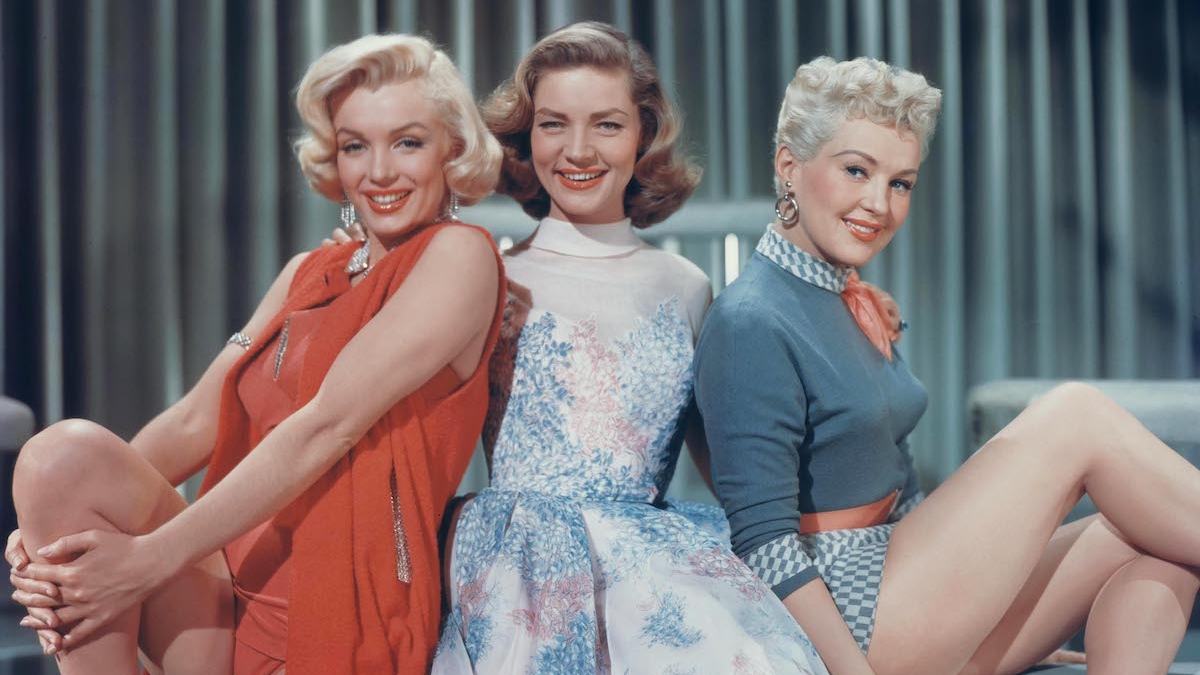
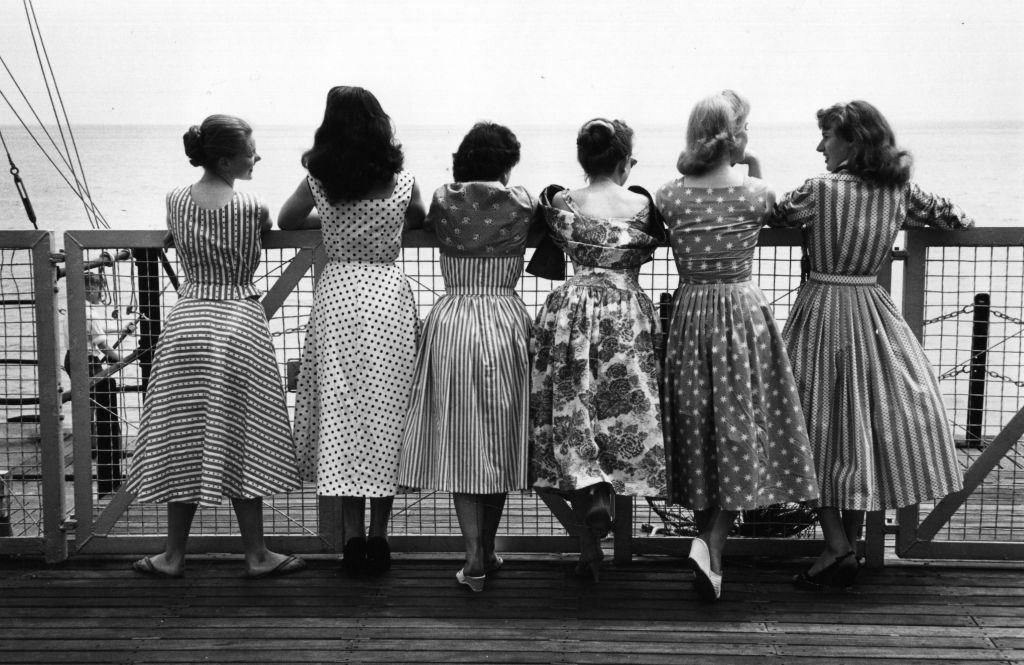

The 1950s Vinateg Style Silhouette
In the realm of 1950s vintage fashion, two distinct silhouettes dominate the scene: the wasp waist paired with a voluminous skirt and the sleek and slender pencil skirt. These iconic looks reigned supreme until 1956 and possess the ability to exude an aura of undeniable allure or exuberant playfulness, depending on one’s personal styling choices.
What makes the 1950s era truly remarkable is its inclusive nature, accommodating various body shapes with grace. Embracing a more voluptuous figure is highly regarded during this time. For those of us who lack curves, fear not, as a little assistance from belts, foundation garments, and ample netting and padding can easily create the desired hourglass shape.
A Bit of History on The 1950s Style
In order to truly grasp the fashion trends of this era, one must delve into the underlying circumstances that shaped people’s lives and subsequently influenced their sartorial choices. It is crucial not to overlook the fact that rationing, in one form or another, persisted until 1958. Despite the nostalgic perception of the 1950s as a vibrant and colourful era, it was, in reality, a time of immense toil for the nation as it strived to regain stability. Nevertheless, amidst the hardships, a surge of jubilation emerged from the triumph of war.
By the decade’s end, the nation’s tireless efforts to rebuild had borne fruit, paving the way for prosperity. The widespread accessibility of televisions and the rise of women in the workforce contributed to the reemergence of disposable income, further fuelling a sense of contentment among the populace. Undoubtedly, these sweeping economic and social transformations held profound implications for fashion, propelling it forward at an unprecedented pace within our country.
Ready To Work! 1950s Vintage Style Movement
The emergence of the “ready-to-wear” trend marked a significant milestone in the realm of fashion. Mass production techniques and notable advancements in garment construction and fabric quality allowed for a wider range of clothing options. This newfound variety was further enhanced by the resurgence of imports, especially from the renowned fashion hub of Paris. In 1947, Dior introduced his revolutionary “New Look” collection to the fashion capital, causing a seismic shift in the industry.
The distinct departure from the sombre aesthetic of the war era had a profound impact. The style was now reinvigorated, resuming its trajectory from the pre-war era as if the conflict had never interrupted its course. Dior’s visionary designs showcased a series of silhouettes inspired by letter shapes. The A-line silhouette, characterised by a widening towards the hem, was swiftly succeeded by the Y-line, featuring wide Dolman sleeves that tapered down to a slim skirt.
Nevertheless, Dior’s initial creation continued to dominate the fashion landscape for many years as the industry nostalgically looked back to the past. The boned bodices and voluminous petticoats evoked an era of elegance and refinement, capturing the collective imagination of fashion enthusiasts.
The Rise of the Adolescent
The recognition of the transitional phase between childhood and adulthood, along with the subsequent development of a fashion style tailored to this age group, emerged only in recent years. The emergence of full skirts, form-fitting tops, capris, and flat shoes garnered significant popularity among the youth, particularly those inclined towards jive dancing. These trends, in turn, exerted a notable influence on casual wear for both men and women, transcending various age groups. Equally influential was the emergence of the ‘sweater girl’ look, which celebrated the feminine beauty ideal of a prominent and pointed bust. This desired silhouette was achieved through the use of the bullet bra, a conical pre-padded undergarment designed to uplift and enhance the bust, creating a captivating visual effect.
-
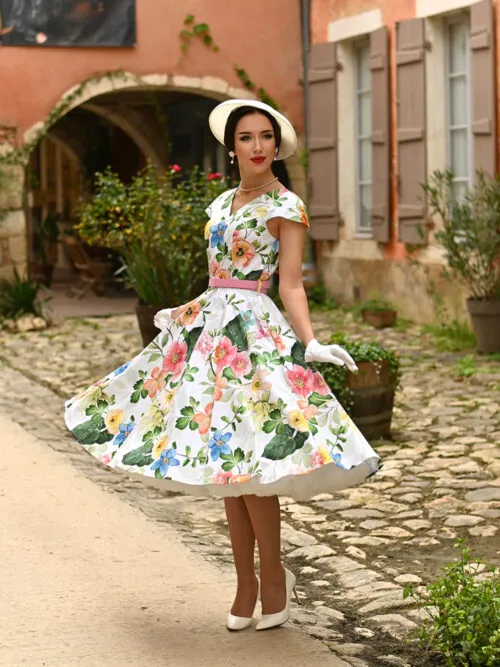
Lottie Swing dress
£69.00 Select options This product has multiple variants. The options may be chosen on the product page -
Sale!

Paris Sparkle Swing Dress
Original price was: £79.00.£69.00Current price is: £69.00. Select options This product has multiple variants. The options may be chosen on the product page -
Sale!

Caitlin Tartan Swing Dress
Original price was: £79.00.£65.00Current price is: £65.00. Select options This product has multiple variants. The options may be chosen on the product page -
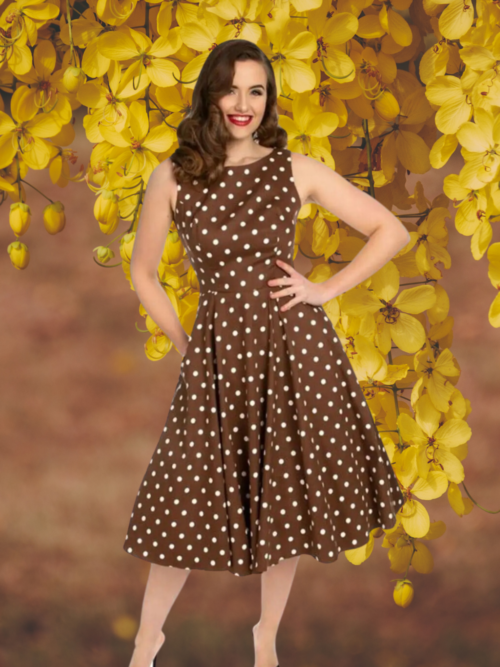
Julia swing dress
£69.00 Select options This product has multiple variants. The options may be chosen on the product page
Petticoats and full skirts
In the past, women often adorned themselves with expansive, circular, or pleated skirts, paired with multiple layers of petticoats to create a voluminous effect. These skirts were a prominent fashion choice for both daytime and evening attire. It was customary for the skirts to fall to mid-calf length, never shorter, though occasionally longer for eveningwear.
The petticoats themselves consisted of several layers of net fabric, which were typically stiffened with starch to achieve added rigidity. Alternatively, for eveningwear, petticoats were made from delicate chiffon, creating a frothy and ethereal appearance. These chiffon petticoats were available in vibrant hues of green, pink, and yellow, adding a splash of vivid colour to the ensemble.

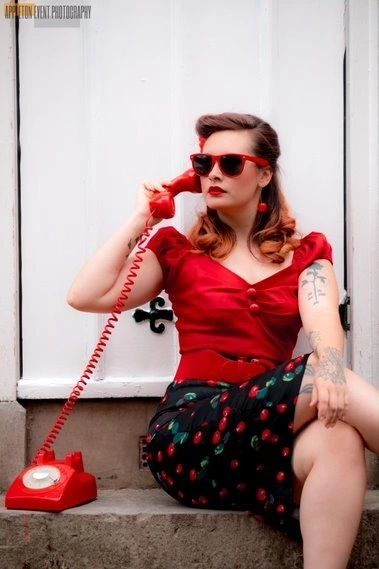
Pencil Skirts
The hobble skirt, a tight and streamlined garment, posed a challenge for women’s mobility, accentuating their curves with restricted movement.
This style, falling from the natural waist with minimal fabric, featured a discreet black split at the back. Pencil-line dresses gained popularity across all age groups, exuding sophistication, and elegance, particularly among mature women who paired them with heels and an abundance of accessories. For a touch of glamour, the wiggle dress complemented a swing coat flawlessly.
Alternatively, a pencil skirt could be paired with a shirt or sweater and worn with flats for a more playful interpretation of this iconic look. However, it is crucial to consider the length of the skirt, as a true 50s aesthetic is best achieved with a calf-length hemline.
The Sweater Girl Look
The emergence of the tight sweater can be traced back to the 1940s, where it quickly gained popularity and continued to be a fashion trend throughout the 1950s. Interestingly, its aesthetic may come across as somewhat surprising to contemporary observers.
The primary intention of this style was to accentuate a pointed and conical-shaped bust, often paired with a bullet bra. Curiously, the present-day rounded bust shape would have appeared unusual during the 1950s, as the prevailing beauty standard revolved around achieving this bosom shape.
Consequently, numerous vintage dresses were designed to accommodate and enhance this desired silhouette. It is noteworthy to mention that the sweater underwent a transformation, evolving from a simple turtleneck into the iconic twin set, which became a staple of 1950s fashion.

Get the 1950s Vintage Look: Our Top 3 Tips to Get You Started
Tip 1: The Foundation
In earlier days, foundation garments held great significance as the core building blocks of fashion. However, in today’s world, knickers have evolved into a more contemporary and trendy style, often associated with hipster culture. It is interesting to note that during the 1950s, the waistline was typically positioned at the natural area just above the belly button. This poses a challenge for those desiring to wear a pencil skirt, as modern underwear often leads to unsightly bumps caused by these knickers. Hence, our initial recommendation revolves around acquiring the appropriate knickers to alleviate this predicament and ensure a flawless appearance.
Tip 2: Accessories
The importance of accessories during this era cannot be overstated. It was unthinkable for a woman to step out of her home without adorning herself with gloves, a hat, and a handbag. Hats came in various styles, such as the delicate lampshade design, wide-brimmed hats, or the elegant pillbox shape, often accompanied by a graceful veil. Gloves played their part too, with long ones being worn in the evening and pushed down to reveal beautiful bracelets, while shorter gloves were preferred for daytime outings. Scarves were also a must-have, worn to tie up hair, adorn the neck, or even create a chic ponytail. Bold colours were encouraged to make a statement. And when it came to belts, a small waist was the ultimate accessory to achieve the desired look, whether paired with a full skirt, a pencil skirt, or capri pants. Wearing a belt accentuated the slender waist that fashion demanded during this time.
Tip 3. Makeup
In the 1950s, the vibrant shade of red known as “Lippy Red” gained significant popularity, leaving a lasting impression. However, it is crucial to select the appropriate red hue that complements your skin tone. For individuals with rosy complexions, blue-based reds are recommended, while those with warmer, yellow undertones should opt for reds with a warm undertone. As for individuals with other skin tones, a true red shade is universally flattering. To achieve the desired effect, it is advisable to start with a lip pencil, filling in the entire lip before applying the lipstick.
1950s Fashion Shopping List
If you are in search of a captivating rock n roll style or yearning for the elegance of Christian Dior’s iconic ‘new look’ from 1947, we invite you to explore our comprehensive shopping guide. Within it, you will find a carefully curated capsule wardrobe specifically tailored for the vibrant 50s era. This collection serves as the perfect stepping stone for your fashion journey, ensuring you have all the essentials to create your desired look.
- Pencil skirt
- Crew neck cardigan
- Petticoat
- Circle skirt or dress, preferably halter or boat neck.
- Bullet bra
- Waist knickers
Must-have accessories:
- Red lipstick
- Chiffon scarf
- Gloves
- Waist-cinch belt
-
Sale!
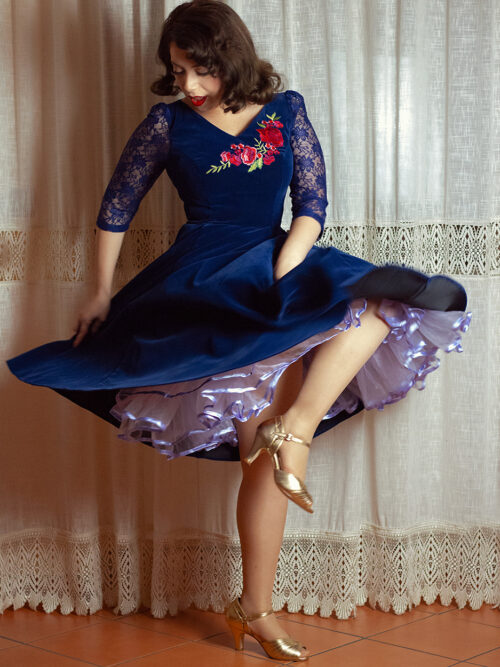
Blue Velvet Rose Swing Dress
Original price was: £79.00.£69.00Current price is: £69.00. Select options This product has multiple variants. The options may be chosen on the product page -
Sale!
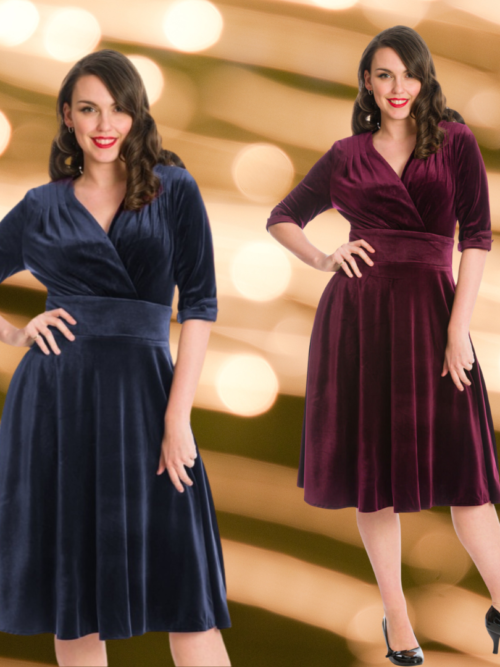
Evelyn velvet swing dress
Original price was: £65.00.£55.00Current price is: £55.00. Select options This product has multiple variants. The options may be chosen on the product page -
Sale!
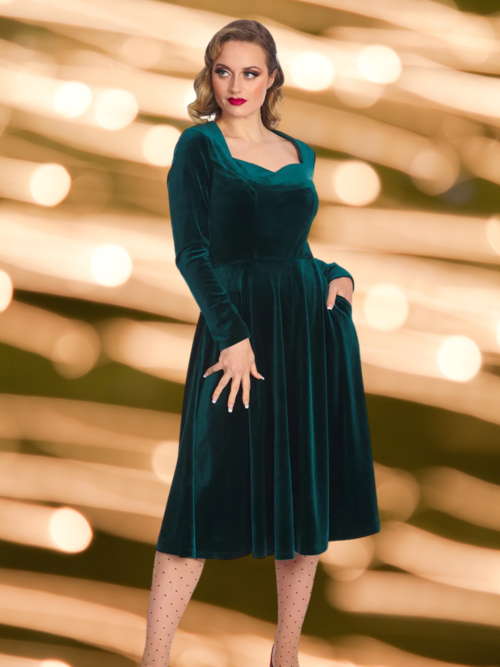
Gracie velvet dress Size S (UK 10)
Original price was: £65.00.£55.00Current price is: £55.00. Add to cart -
Sale!

Caitlin Tartan Swing Dress
Original price was: £79.00.£65.00Current price is: £65.00. Select options This product has multiple variants. The options may be chosen on the product page -
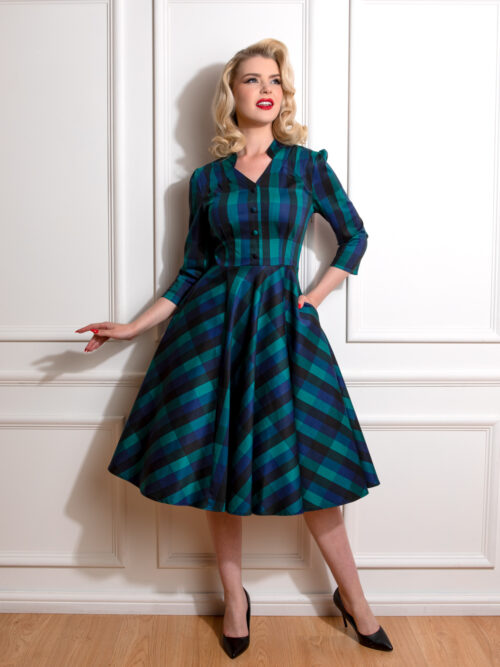
Louisa tartan swing dress
£79.00 Select options This product has multiple variants. The options may be chosen on the product page -
Sale!

Poppy blue lace dress UK size 8
Original price was: £60.00.£30.00Current price is: £30.00. Add to cart -
Sale!

Paris Sparkle Swing Dress
Original price was: £79.00.£69.00Current price is: £69.00. Select options This product has multiple variants. The options may be chosen on the product page -
Sale!
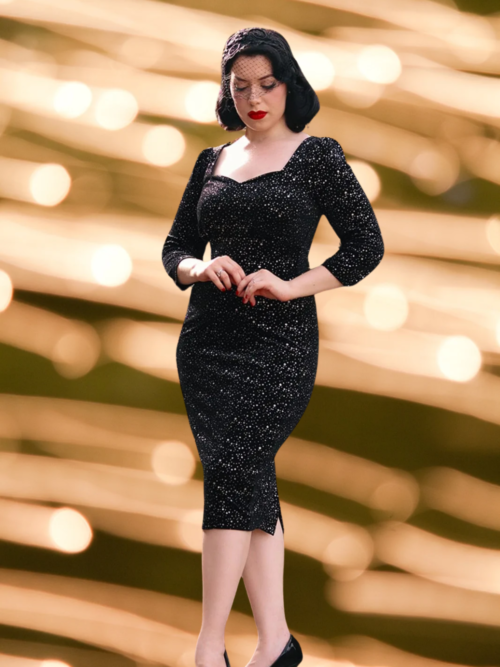
Samantha Sparkle Wiggle Dress
Original price was: £60.00.£40.00Current price is: £40.00. Select options This product has multiple variants. The options may be chosen on the product page -
Sale!

Scarlette swing dress
Original price was: £69.00.£59.00Current price is: £59.00. Select options This product has multiple variants. The options may be chosen on the product page -
Sale!
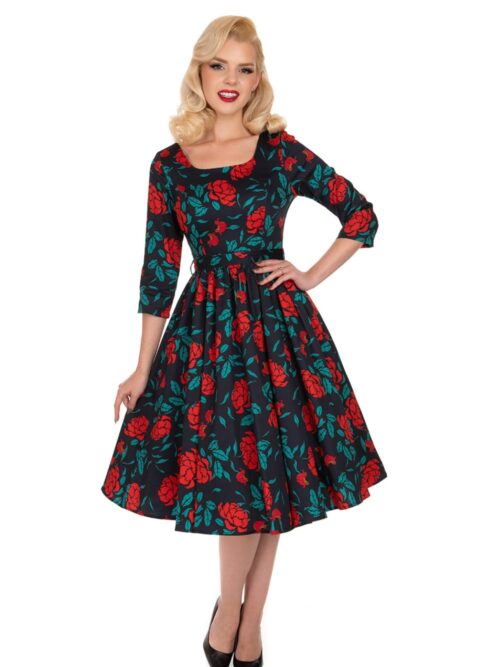
Dahila Swing Dress
Original price was: £79.00.£59.00Current price is: £59.00. Select options This product has multiple variants. The options may be chosen on the product page -
Sale!
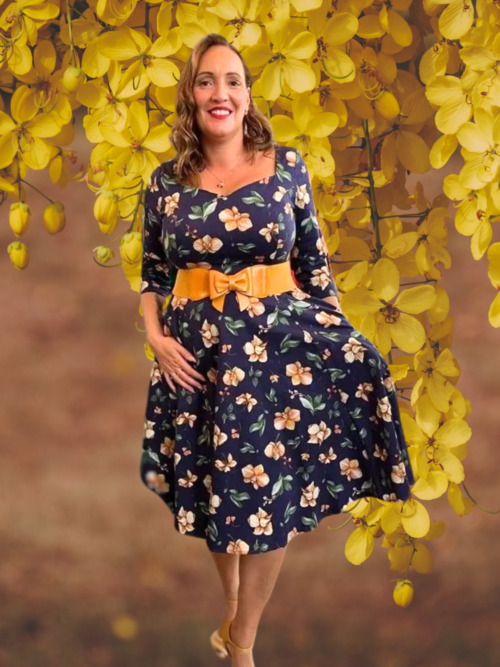
Sherie Floral swing dress
Original price was: £79.00.£60.00Current price is: £60.00. Select options This product has multiple variants. The options may be chosen on the product page -
Sale!
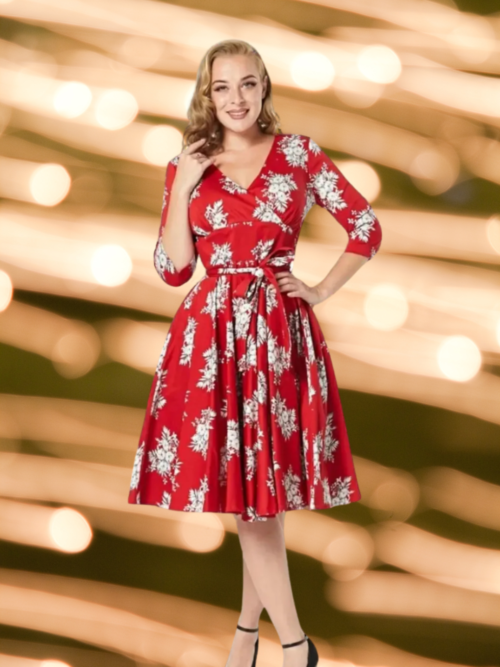
Ruby red floral swing dress
Original price was: £79.00.£69.00Current price is: £69.00. Add to cart
